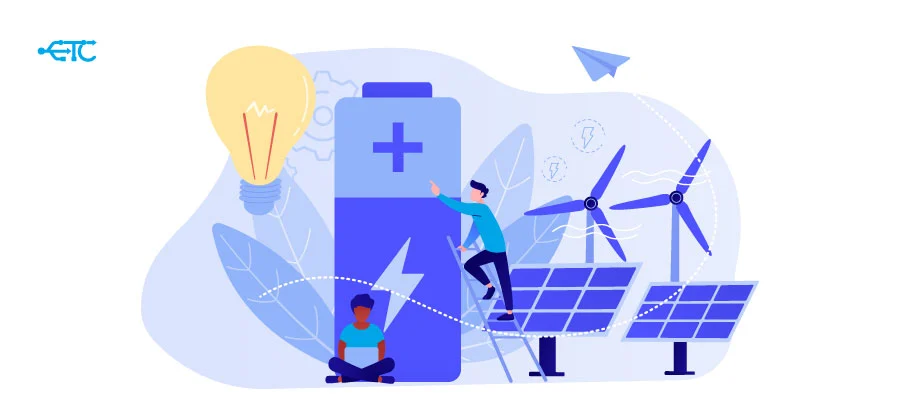Digital transition at the service of the energy revolution

Digital transition imposed itself on many countries of the world including France and this is due to the use of fossil fuels as well as global warming.In addition to the environmental aspect of this transition, there is also an aspect relating to technological and societal changes. Energy transition was accompanied by a digital one in response to the rise of new technologies which have a significant impact on operating modes in general. We then wonder about the energy transition different challenges and issues to be faced in the era of the digital revolution.
What impacts and what adaptations?
Energy transition in France
In France, a law published in 2019 emphasises the need for achieving an energy revolution by aiming at reducing by 50% the share of nuclear in total energy consumption, opting for measures supporting renewable energies and others meant to boost energy performance as well as the increase in offshore wind capacity. An energy that would allow to finalize the Paris Agreement and implement the scenario “450” which involves the effective fight against climate change which can only be done if renewable energies will have as a share no less than 40% of the energy mix by 2040. The findings show both a delay in France at this level and that the target objective has not yet been achieved. In order to guarantee the success of an energy transition, the digital revolution is emerging as the keystone of the process.
It takes the place of a true partner of choice in the energy transition process. It is therefore a question of providing answers to a major question: How to bring about successfully energy transition through new digital technologies? What is green energy technology?
Green energy production technologies are indeed part of the solution by offering also constantly decreasing costs. Nevertheless, it is clear that a common convergence to both the digital transition and the energy revolution must come to life. In fact, the two subjects will have to be treated jointly by questioning whether digital technologies represent a benefit for the environment or the opposite.
What is digitalization in the energy sector?
Faced with increasingly tough competition where it is a question of gaining in competitiveness, players in the energy sector find themselves faced with the obligation to follow the wave and to implement in turn their digital transformation in order to be able to adapt quickly to recent market trends. Players commit more and more investment in the digitalization process with investments of almost 20% per year. Moreover, the energy sector in France, which continues to be dominated by historical giants, while it has been liberalized for 10 years, will be disrupted by changing consumer expectations. As such, digital transformation will exert influence on all known practices in the sector, whether they be activities related to industrial tools, the customer relationship or the adoption of the surrounding culture behaviour patterns.
What are the key elements of digital transformation?
Digital transformation is therefore done in three parts:
- Digital transformation that affects the structure :Players in the energy sector will have to question their activities through the implementation of a new value chain, the integration of digital solutions such as open innovation, big data, IoT, artificial intelligence etc. And by identifying new business models through investments or the acquisition of innovative organizations.
- Digital transformation focused on the customer relationship :
Digitization is essential in the management of the customer relationship and the improvement of satisfaction. Digitizing the customer experience is a fundamental element for which it is necessary to provide more rapid response, optimization, recommendations or even integrated proposals. - Digital transformation at the cultural level :
Management must also be involved in digital transformation and this implies the implementation of a more agile model for the benefit of communication between employees outside silos, the recourse to specialized skills, in data science in particular, as well as a digital culture that is properly disseminated throughout the company.
Digital solutions for a successful energy transition
What are energy transition technologies ?
What would a successful energy transition be without the significant contribution of digital tools and innovation ?
Indeed, new technologies are implemented such as blockchain, smartgrids or IoT. Regarding smart grids, it is a question of a preponderant role in the energy transition. Indeed, electricity needs, which are increasing more and more and which are accompanied by a need to better control electricity consumption, led to the obligation to adapt the electrical networks by imbuing them with the smart character.
Smart grids or intelligent networks constitute computer technology solutions which allow the flow of electricity circulating between suppliers and consumers to be adjusted.
This digital solution will allow the collection of information regarding the state of the electricity network, after which it will be put to use in the adaptation between electricity production, its distribution and its consumption.
As to smart meters like Gaspar from GRDF or Linky from Enedis, they give consumers the possibility to evaluate and carry out an instant follow-up of their level of electricity or gas consumption and even to be able to take the actions needed to reduce energy costs.
It should be noted that at the beginning of their installation , smart meters faced resistance from French households which later on became accustomed to their use. Moreover, nearly 70% of consumers consider that smart meters are helpful when it comes to real-time consumption monitoring. In addition, it is a question of blockchain technology which allows the realization of purchase and sale transaction without the establishment of a centralized control, while reducing costs and enforcing faster transactions.
The advent and the development in the use of connected objects and digital solutions have largely promoted the energy transition. Between connected bulb, smart electricity meter, smart thermostat or other connected objects, there is now a real effort made to control energy costs through more optimized consumption.
